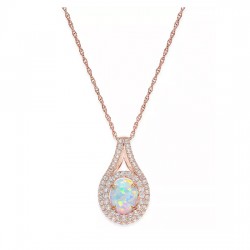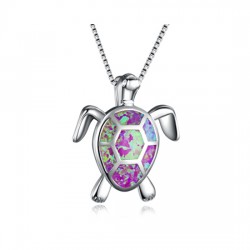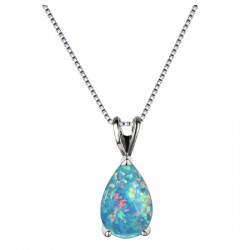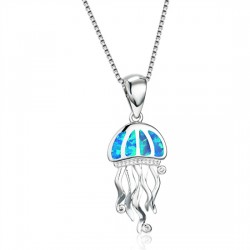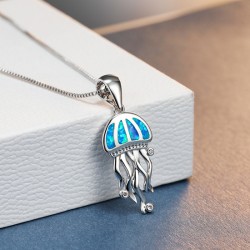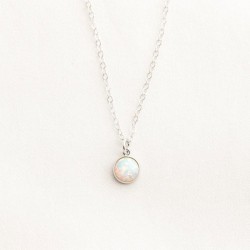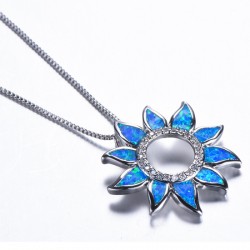Complete Guide To Opal Necklace
Opal necklace is exquisite and one-of-a-kind in terms of color and beauty. Opal is available in a wide variety of kinds, shapes and colors. We will show you different styles of Opal necklace, different sorts of Opals, different settings, and where to find the best Opal necklace in this "complete guide to Opal necklace".
Birthstone - Opal
Opals, the traditional October birthstone, may have originated in India (the country from where the first opals were imported to the West). Opal is known as upala in Sanskrit, which translates to "precious stone." In Roman times, this was referred to as Opalus. Rare opals with play-of-color, in which the stone's colors shift and morph in response to light, fetch the highest prices.
The brilliant mix of colors in the October birthstone has been likened to fireworks, galaxies, and even volcanoes. The Bedouins once believed that opal contained the lightning that fell from the sky during thunderstorms. Opals were revered by the ancient Greeks for their mystical qualities and their supposed ability to foretell the future and ward off illness. In European culture, opal has always been a symbol of honesty, optimism, and purity. One time, people believed that opals had all the powers and properties of other gems.
Different Sorts Of Opals
Natural Opals
In contrast, opals that have had no further human intervention than cutting and polishing are dubbed natural opals. Bright, dark/black, boulder, and matrix are common ways to describe the color and clarity of natural opals. Even though boulder opal has a natural ironstone substrate, it is still considered a solid natural opal. The variation of natural opal is determined by its body tone and transparency.
Body Tone: Opals can be found in a wide variety of body tones, from pure white to a wide spectrum of shades of grey and even black.
Transparency: Depending on their body color, opals can be either transparent or opaque. When the color clarity is flawless and the opal is transparent or highly translucent, it is often referred to as crystal opal.
Black Opal
Black opals, which are most common on Lightning Ridge, are the rarest and most precious type of opal. The best quality stones are quite rare. Easily distinguishable since the "body tone" or backdrop color is black.
To the naked eye, the difference between a black opal and a black/dark opal is the presence or absence of color play inside or on the opal's dark body tone. It may be see-through or it may be opaque.
Sometimes the potch of a black or dark opal has a light crystal color bar running through it, making an otherwise transparent stone seem black (colorless opal). Even the most expensive black or dark opals may show the faintest of color bars on black potch.
Most black or dark opal comes from the mines at Lightning Ridge, New South Wales. Because of its greater scarcity, black opal is often more expensive than light and even boulder opal, although having similar hues, purity, and patterns.
Rarely do you see a black or dark opal with brilliant red flashes.
White Opal
Light opals are those found in nature that have a base tone anywhere from colorless to a mild grey. It's common to refer to them as "white," yet that label really only belongs when the body color is excessively milky.
Light opal accounts for the vast bulk of the precious variety. Despite its "milky" look and light body tone or white body hue, White Opal can be anywhere from translucent to nearly opaque.
Mainly mined at Coober Pedy and Mintabie in South Australia, although the earliest resources were discovered there.
Fire Opal
Fire Opals, which come from Mexico or Brazil, are highly sought-after for their stunning orange, yellow, and red "fire" tones. The most expensive specimens have homogeneous color and a bright red or orange tone. However, if the Opal dries out, which for this form of Opal can sadly result in cracking, milkiness may occasionally be noticed. Customers prize "fire Opals" for their lovely hues and typically lower price, despite the fact that they frequently lack the color play that distinguishes Black Opals so clearly. However, these are less common for an engagement ring because they are more likely to crack and are therefore less desirable.
Boulder Opal
The host rock naturally forms as part of the gem in the case of the precious opal type known as boulder. There is frequently only a tiny vein of expensive opal. In Western Queensland, it mostly happens in a few select areas. Boulder opal forms when cavities or crevices in ironstone boulders are filled. Boulder opal can range in color from light to black, depending on how the stone appears when seen from the ground.
Since the middle of the 1970s, this type's popularity has exploded. Boulder opals are in high demand and can be very expensive; they are always cut including the host brown ironstone. Andamooka, South Australia, also has a form of boulder opal, with quartzite serving as the host rock. Known as "painted women," these are typically only suited for display.
Different Settings of Opal Necklace
Make sure to speak with a seasoned jeweler if you're thinking about having a custom item produced and want the most secure setting. Opals are delicate and brittle, thus jewelers must be careful when mounting them and what to place them in.
Most Secure Opal - Bezel Setting
While there are several techniques to place a stone, bezel setting is the safest and, logically, most challenging method. Bezel setting entails hammering a lip of gold (or other chosen metal) over the edge and all the way around the gem, totally encasing the stone's edge for safety. The stone is protected from tampering by the bezel setting, while a small hole at the base allows the stone to shine from within. The beauty of this technique is that it completely preserves and safeguards the stone. The jeweler risks shattering it into a million pieces if he is not careful when using the hammer to strike it.
Jewelers often use epoxy on the bezel to secure the gem and avoid damage to the opal from the metal during the setting process (or prongs). Oil is used to prevent the epoxy from permanently adhering to the Opal in case the owner ever decides to reset the Opal.
Claw Setting
Claw setting, sometimes referred to as prong setting or basket setting, is a flexible technique for incorporating gemstones into jewelry designs. Wire is used to build the prongs and claws that will hold the gemstone in place as well as the frame the stone will sit in.
This method can be applied to opals of various sizes and shapes, and it is ideal for those with unusual shapes and cuts because you can customize the setting to match.
The 6, 8, and 12 claw settings are variants on the motif of shared prongs for gemstones. Jewelers usually use prongs for mounting domed cabochons. Since the Opal will now be viewable from all directions, it may be admired from any angle. Three prongs are needed for forms like teardrops and triangles, with at least one V-shaped prong to protect the point from chipping, whereas ovals need four.
Plus, it may be incorporated into countless necklace, earring, and bracelet designs; your imagination is only the limit!
Designs For Popular Opal Necklaces
Pendant
You can get an opal necklace in this specific style with a chain made of either silver or gold. The pendant for this necklace is made of opal. It is a flexible necklace that goes with just about everything in your closet.
Boho
The bohemian lifestyle gave rise to the fashion for boho jewelry. It's characterized as independent, tribal, and ethnic. Boho fashion owes a debt of gratitude to hippy culture. However, it has evolved to be more open to new ideas and influences.
You can wear a regular outfit and still be true to your Boho roots with the help of an opal necklace. It frees you from the mundane, allowing you to try out new looks.
You probably won't have two boho necklaces that are the same because they are both handmade. Original bohemian is now infused with an urban edge to keep up with the ever-changing tastes in fashion.
Bright colors, fabrics, leather, rattan, and other organic materials are all included in distinctive bohemian jewelry. Tassels and fringes are also available to complete the ideal boho style.

